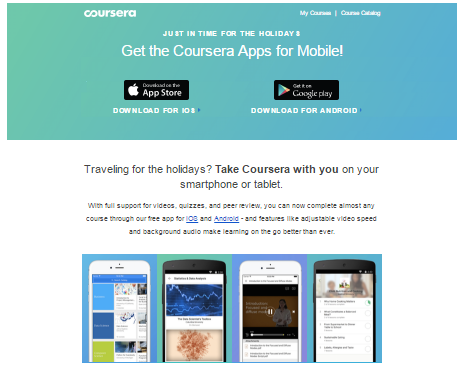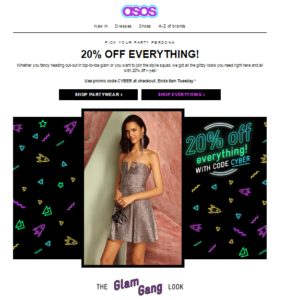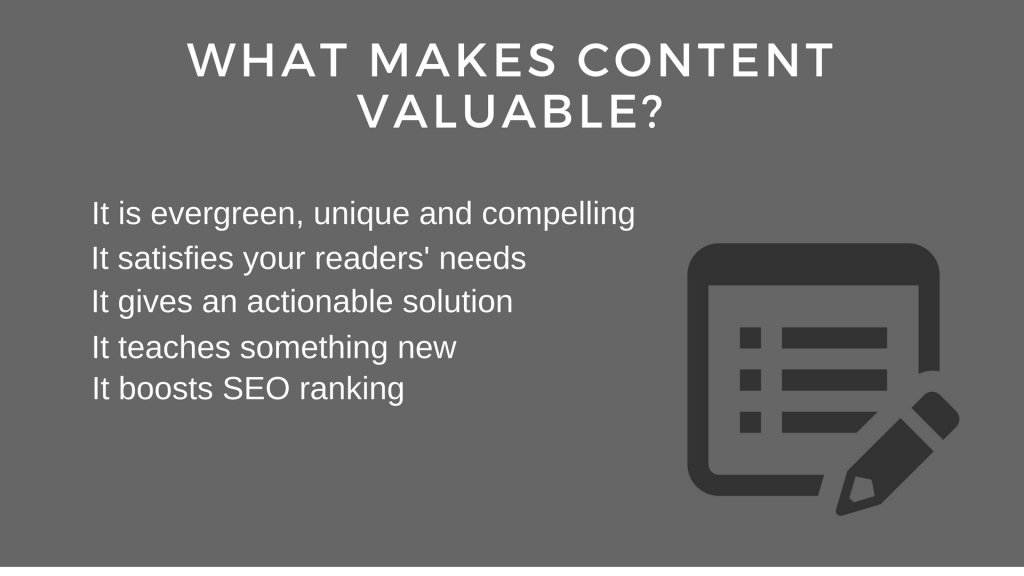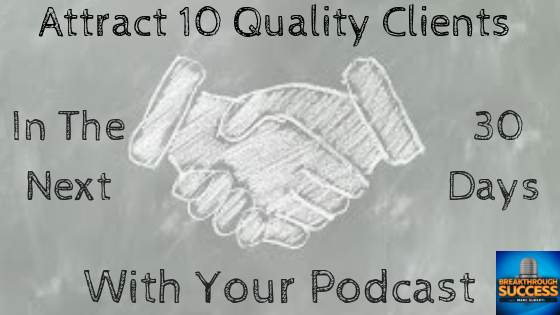
Want to see how I can help you grow your podcast? Schedule a free strategy session today!
A podcast is your goldmine for attracting high-quality clients to your business. Podcasts give you the ability to attract listeners and guests to your show. And while there’s already so many blogs and YouTube channels out there, podcasting is ripe with opportunity.
Convince and Convert laid out several fascinating statistics for podcasting in 2018. They provide 13 important statistics, but these are the three we should pay attention to.
- In 2018, Six Million More Americans Listen to Podcasts Weekly versus 2017
-
- Takeaway: Podcasts are growing
- 23 Percent of Americans Have Listened to Podcasts in the Car
-
- Takeaway: You can’t read blog posts or watch videos while driving. Podcasting provides a competitive advantage due to the audio nature of the content
- 18 Percent of Americans Now Own Smart Speakers
-
- Takeaway: More smart speakers are coming soon, and more people will say, “Alexa, play the podcast Breakthrough Success.” It helps to mention 49% of podcasts are listened to at home…BUT wait until smart speakers are built into cars and podcasts become as mainstream as radios. It’s already happening.
Podcasting is growing, and if you have a podcast, you’re riding a big wave right now. For people who don’t have a podcast, it’s best to first decide what your show will be about and who you’ll serve.
We won’t dive too deep into starting a podcast, but it’s worth mentioning for anyone who doesn’t have a podcast yet.
You can host your podcast using a site like Libsyn, Pippa, Blubrry, or another podcast hosting company. I personally use Libsyn because it allows me to easily publish podcast episodes on iTunes, Spotify, Stitcher, and on other podcast players.
Your costs for producing episodes depends on how many you produce. I produce 3 episodes each week for Breakthrough Success. That comes to roughly $20/mo on Libsyn and around $28/episode after I pay my audio editor and show notes writer. At 3 episodes per week, it comes to about 14 episodes per month.
I also spend $20/mo for Acuity which makes scheduling episodes a breeze. You get most of the features with a $10/mo account, but I run several calendars on Acuity which is why I pay $20/mo.
I also use Skype’s Call Recorder to record podcast episodes. If I want to record a video interview, I’ll use Zoom.
My total expenses for hosting the podcast stand at around $450/mo. Why would I undertake an investment like that when I could use that $450/mo on other things (or save it. Or buy stocks and real estate).
The answer is that one $997/mo client pays off all of those expenses. And my podcast brings in more than enough clients to pay for itself.
Plus I get to interview influencers and learn so much from them while providing my listeners with epic content 🙂
How Much Money Can You Make Podcasting
Client attraction is one of the top ways to make money with your podcast. Remember how I mentioned you can get $997/mo clients by hosting a podcast?
Get 9 of those types of clients from your podcast, and you’re at a nifty 6-figure income. Get 21 of those clients and you’re making over $250K every year.
The math adds up, and the best part is that client attraction isn’t the only way you can make money with your podcast. Some people listening to your show won’t want to become your clients right away.
You need to strengthen the relationship with them through your episodes and get them to put some skin in the game. “Putting skin in the game” is marketing talk for turning a listener into a customer, even if it means a $1 purchase.
It’s very easy to create something and charge $1 for it. In most cases however, you’re better off pricing that product at $7 or at $5/mo to boost your profitability.
The product I promote on Breakthrough Success depends on the timing. Right now, I’m promoting the heck out of Podcast Domination. I’ve mentioned it in every episode lately and charge $0.99 during the preorder phase.
Some of the people who buy Podcast Domination may become clients in the future. But the great thing is that each customer is a strong lead. I consciously write my books with the intention of building the dialogue, landing more clients, and boosting overall product sales. My books act like silent salesmen.
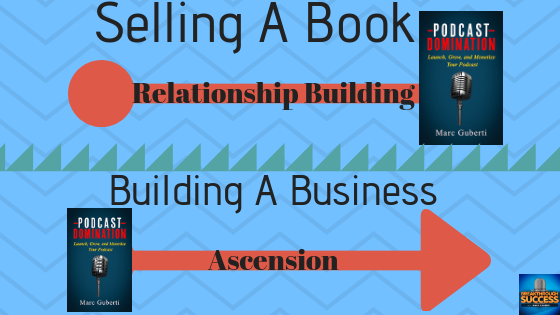
This blog post is a silent salesman, and I hope you buy my book through this link 🙂
Oops. Not so silent anymore. We all gotta make money to continue pursuing our dreams at a high level of intensity.
But going back to the book, I use the book to achieve a few key objectives:
- Fulfill the promise that a reader will learn how to grow, launch, and monetize their podcast by reading the book. If you don’t fulfill your promises (i.e. unethical clickbait), nothing else matters.
- Demonstrate my expertise because potential clients only hire people who demonstrate high expertise and/or a low price. Since I don’t underprice myself, I focus on providing massive value to demonstrate I know what I’m talking about.
- Provide a call-to-action. At the END of the book, I tell readers how they can schedule a free strategy call with me. I DO NOT include this link at the beginning of the book.
While I’d get more strategy call sessions by including the call-to-action at the beginning of the book, some people would find that link through Amazon’s preview option.
That preview options allows you to view the first 10% of any Kindle book free of charge. That means I’d be on strategy calls with some people who didn’t put any of their skin in the game. Sometimes you can turn these people into clients, but it’s much easier to convert someone who has already made some kind of investment in what you’re doing, no matter how big or small.
Remember, at $997/mo, you only need 9 clients to make 6-figures. You just need 6 clients if you raise your services to $1497/mo.
How To Charge Those Kinds Of Prices
The higher you charge, the fewer clients and customers you need to reach your income goals.”
For some people, charging $97 for a consultation session is difficult. Technically, it’s easy. Just change the order page or PayPal button to reflect the new price. However, some people don’t believe their consultation session is worth $97. These people are underpricing themselves.
Other people command $1997 price points just to spend an hour with them. There are services that cost five figures each month, and some people have no problem writing a $1 million check for a Lamborghini.
$997/mo is the example I’ve used, but if you can (note: yes, you can) charge higher than $997/mo, then you need fewer clients to hit your income goals.
Ask yourself what it would take to double your price without doubling the time you spend on each activity. You don’t go from $97 to $197 by going from a 30 minute consultation session to a 1 hour consultation session. How can you make that same jump without the extra 30 minutes.
The two answers to this question are demonstrating your expertise and showcasing your credibility. It’s no wonder the highest priced products and services are flooded with testimonials.
Want to get high profile testimonials? It’s not as difficult as you think. Interview high profile guests on your podcast. Build relationships with them. Tell them about your product or service and offer it for free (for an ongoing service like scheduling social media content, offer one free month).
Then you’ll start getting testimonials from key players in your niche. Some of those same people may become clients or buy a bunch of your products. Even if none of those key players become long-term clients, those testimonials will provide you with strong social proof as more people come across your products and services.
Notice how the podcast helps with a key element in converting people into clients? If you do it right, you can also use the podcast to demonstrate your expertise as well. You can release a solo episode every week, share insights in between a guest’s answers, and do a bunch of things to demonstrate your expertise during each episode.
So How Do We Actually Get Clients
Everything you’ve currently read has been the set-up for attracting clients with your podcast. If you have been skimming, I recommend quickly scrolling up and gleaning the key highlights from what I mentioned earlier.
Most prospects turn into clients through free strategy sessions. Almost everyone in the business leads people into a free strategy session to convert them into a client. Anytime I’ve hired a coach, I made that decision based on a free strategy session.
If you want clients, then you will need an Acuity account. Acuity makes it easy for you to create a calendar that only shows the times when you are available. That way, it’s easier for prospects to pick times that work for you instead of engaging in a back-and-forth conversation to find the ideal time.
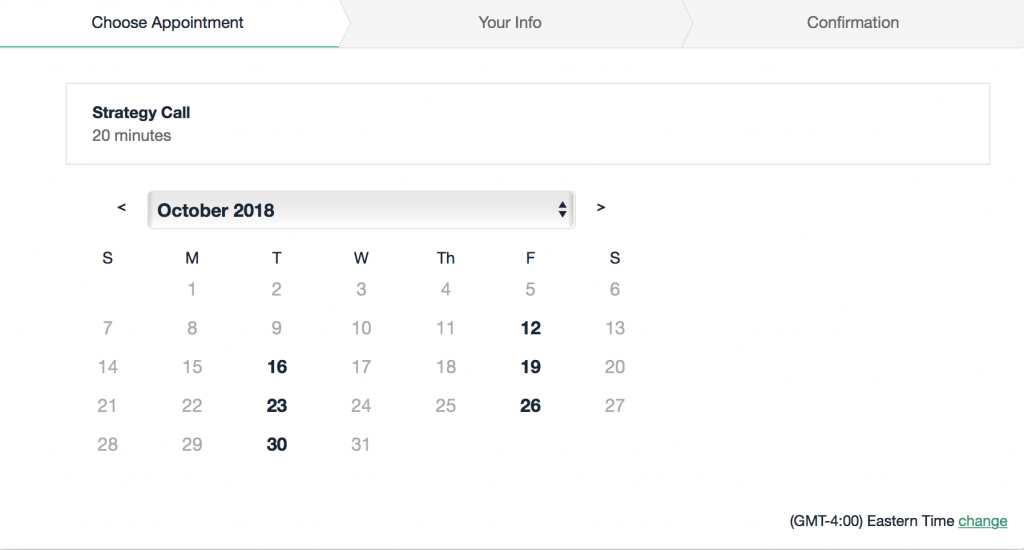
If you even have to engage in that kind of back-and-forth conversation, you will lose clients.
Acuity is the best option available, but it comes with a universal problem all calendar apps come with. The long link problem.
Remember, you’re goal is to recruit clients with your podcast. If we were talking about blog posts, you could easily include a hyperlink to your schedule page and move on.
But with a podcast, that option doesn’t exist. You have to verbally say what the link is. I ran into this problem when promoting my book Podcast Domination. On a blog, I can just include that hyperlink in there.
On a podcast, I have to figure out how to tell people to visit this link:
https://www.amazon.com/gp/product/B07FSHGR9N
I’d have to say Amazon dot com slash gp slash product slash B07FSHGR9N during the episode. That’s hard to say while keeping the episode natural. It’s even harder for a listener to remember.
Especially if that listener is driving like the 23% of Americans who listen to podcasts in the car.
I took that same link and turned it into this:
Much easier for me to say and even easier for a listener to remember.
Marc Guberti dot com slash P D is much easier for people to remember than the other one.
How do you create links like this? If you have a WordPress powered blog, I recommend the Pretty Links plugin. It’s the one I used to create the link above, and I also get to track stats. By creating a custom link for my podcast, I can track how many clicks can be specifically attributed to my podcast.
You can do the same thing with bit.ly links. You can customize the text that appears after the slash. The link http://bit.ly/podcastdomination also gets you to the book’s Amazon Page.
The only danger with using bit.ly is that your ideal link might be taken. For instance, bit.ly/pd will send you over to someone’s Flickr Profile. Therefore, I can’t use that customization to link to my book.
Distribute Each Episode For Added Exposure
You now have a solid foundation for attracting clients with your podcast. Now you need to spread the word and attract more listeners to your show.
You could technically still reach your 10 client goal without getting a single podcast download, but it helps big time to have a strong listener base. More listeners means more potential clients.
You have to start by getting your podcast on iTunes, Stitcher, and Spotify at the very minimum. The more podcast players you can get on, the better.
That’s something you get out of the way the moment you start your podcast. A good podcast hosting company like Libsyn will provide you with quick and simple instructions on how to get your podcasts on those places.
You should also get your podcast on Alexa. Since that’s still new, I’ll briefly talk about it since home speakers are still an emerging trend. All you have to do is fill out TuneIn’s podcast submission page and wait for approval.
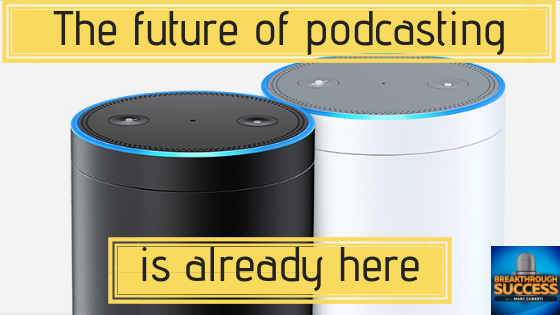
If you ask Alexa to play a podcast, it will search on TuneIn to find a podcast that matches up with your request.
That’s why if you say, “Alexa, play the podcast Breakthrough Success,” Alexa will play the latest episode. My podcast was approved for TuneIn and now Alexa can play the Breakthrough Success Podcast.
Create A Social Media Posting Calendar
The real distribution begins when you create a social media posting calendar for your podcast. This is where you share your podcast multiple times across all of your social networks.
Most people make the mistake of only posting about their new episodes on the days they come out. There’s no follow-up in this approach which leaves a lot of traffic on the table.
For each new piece of content, you need a weeklong calendar of aggressive promotion. Create several custom tweets, post on Facebook, pin on Pinterest, post on Instagram, reach out to influencers, and promote your episodes as far as you can promote them.
For the custom tweets, I include images and quotes from the show. When I include a quote, I always tag the guest. That way, the guest sees I tagged him/her and is therefore more likely to share my content.
Your social media posting calendar may look different depending on your frequency, but you should plan at least a week out. Even when that week is over, you should still continue to occasionally promote each episode you create.
To this day, I’m still promoting Episode #1 of Breakthrough Success because it’s still valuable and a bunch of people haven’t listened to it yet. I also want to give my audience the gift of seeing where I was when I was starting out with the show. You only realize how far you’ve come when you take a look at some of your past stuff.
Distribute Even Further With Repurpose.io
Repurpose.io is an awesome tool that allows you to do as the name suggests—repurpose your podcast episodes.
You can turn your podcast episodes into YouTube and Facebook Watch videos for $12/mo. Before this tool, I invested several hours to coming up with audio snippets from certain episodes and posting them on YouTube. However, it was tedious and I didn’t see a big enough ROI.
Repurpose.io is a game changer because it’s all automated. You set it up once and all of your future episodes get published on your YouTube and Facebook channels. I currently don’t have Facebook Watch set-up, but here’s how a Repurpose.io video looks on YouTube.
Pretty nice set-and-forget for $12/mo. You can also pay $20/mo if you want to do this with multiple podcasts and/or Facebook Watch channels.
Interview More People On Your Podcast
Do you remember when I said you could get clients with your podcast without getting a single listener? I wasn’t joking.
Every guest you interview on your podcast is a potential client. You’re in the middle of a sales call the moment the guest joins you on Skype or Zoom depending on what you use to record episodes.
If you interview 100 people for your podcast and get 10% of them to convert, you’ve got 10 new clients. You can interview people who you believe would be great potential clients to work with. You can determine in the conversation if the potential client would be easy or difficult to work with and make your pitch accordingly.
While getting more listeners helps with attracting guests on your show, I find that very few people ask for download numbers. It doesn’t matter if you’re getting thousands of downloads or less than 10 downloads per episode for most potential guests. They just want to be on more podcasts.
100 > 100
Most podcast hosts with 100 episodes under their belt get there by interviewing 100 people. Some get there by interviewing slightly less than 100 people because of the intro episode and a few other episodes. Other hosts get there with a solo show and don’t interview anyone (to that, I say you’re missing out on a lot of relationship building).
Some podcast hosts with 100 episodes have interviewed more than 100 people, hence 100 > 100. In 100 episodes, you can interview more than 100 people. To break that down, in one episode, you can interview more than one person.
In fact, you can technically interview as many people as you want in one episode. Nothing is stopping you from interviewing 3 or 4 people in the same episode.
Just arrange with a group of people to all join in on Skype or Zoom at the same time. Then, ask questions and let all of the guests answer each of the questions you ask. You can allow conversations to develop between guests to add a different flavor to your episodes.
That’s 300-400 potential clients in 100 episodes if all of your episodes are round tables. That’s a lot of potential.
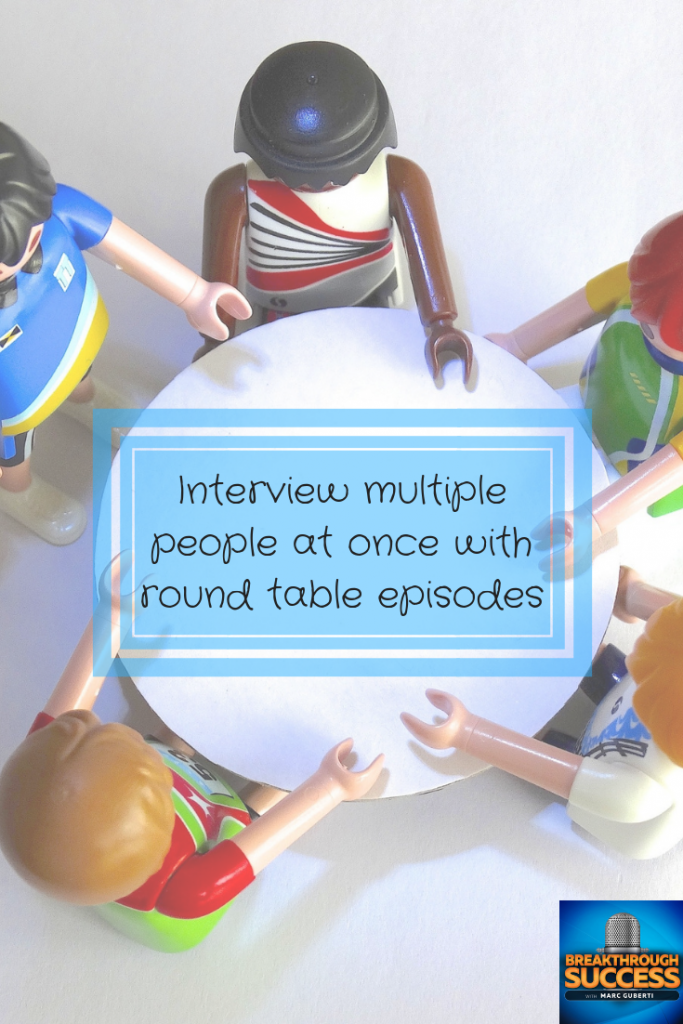
How Guests Become Clients
Earlier I mentioned how you can shorten your link using Pretty Links if you use a WordPress blog or by using bit.ly if you don’t have that luxury. That shortened link is essential to turn guests into clients.
Very few guests will become clients on the spot. Most of them will want a strategy session with you so they can see how you would help them. During the episode, you’re going to mention that link and provide your listeners with the call-to-action.
Your guest is going to hear that same call-to-action intended for your listeners. And if you think about it, your guests are also your listeners. They listen to what you say, wait for you to ask the next question, and then answer it.
If a guest sees you as an expert, they’ll follow up about the free strategy session you mentioned earlier in the episode. You also have the pre and post episode conversations to drive the free strategy call home.
It’s important to not push the conversation towards the free strategy session. Don’t start off by telling the guest about your free strategy call offer. Let the conversation develop.
If the guest asks you what else you do besides the podcast, you can then mention your services and mention that you offer a free strategy session. If the guest expresses he/she has a pain point that you solve, mention that you can solve that problem and you can jump on a strategy session with him/her on a future date.
Some guests won’t be interested in buying your services, but they’ll know people who are interested. For this group of guests, you can ask them for referrals. I only recommend asking for referrals if you get into a conversation about what you do and believe the interview went well.
The Final Step Of The Strategy
Hosting your own podcast allows you to grow an audience and have guests on your show. Both of those groups of people are potential clients. But there’s one more core group we need to tap into for maximum success.
The final step is to interview podcast hosts in your niche. Once you’ve honed in on your pitch and have had some guests on your show, it’s time to reach out.
Some of the podcast hosts you interview will then invite you to be a guest on their shows. This is what you want. When you get interviewed, the host is now a potential client. Depending on how much you wow that host, you might get a client on the spot.
You also get access to that host’s listeners. At the end of a podcast episode, the host traditionally asks a question like, “Where else can we find you?” When you get that question, tell listeners they can schedule a free strategy call with you.
As you get on more podcasts with this strategy, more podcast hosts will reach out to you and invite you to be on their shows. Eventually, you won’t have to do the outreach anymore. All of the podcast hosts will come swarming to you. With each interview, you’ll get your message in front of more potential clients.
At this point, you may have a client overflow. All that’s left to do for this final step is to find and reach out to podcast hosts.
Finding Podcast Hosts
Finding podcast hosts is the easy part. One of the most common ways to find podcast hosts is by searching through podcasts on iTunes and Stitcher (while I like Spotify, it’s still a very music oriented platform, so I recommend doing this research on a platform that only displays podcasts).
Just search your niche, find podcasts, see which ones take guests, and reach out to those hosts (more on outreach coming soon).
There are two other ways you can find podcast hosts.
The first tactic is to go on LinkedIn and search “[your niche] podcast host.” LinkedIn will then display a bunch of people who are podcast hosts in your niche.
All you do at that point is start building relationships.
The second tactic is to google “[your niche] podcasts.” Instead of seeing all of the podcast hosts like you can on LinkedIn, Google will provide you articles. Most of those articles will allow you to easily identify the top podcasts in your niche.
For instance, when I Google “business podcast,” I get these results
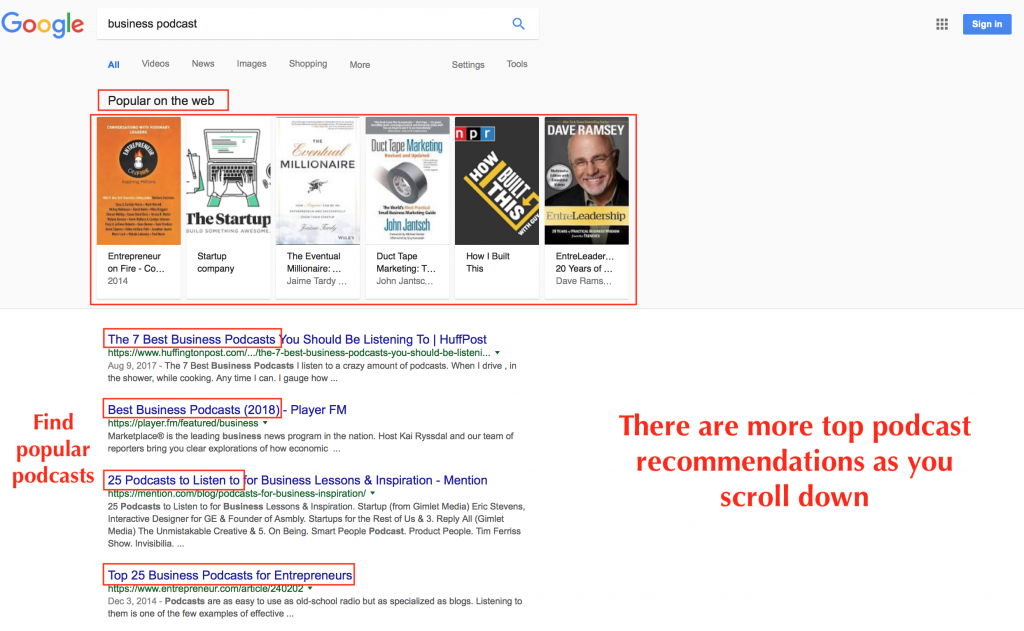
A lot of these articles lead to curated lists of top podcasts in your niche. These podcasts are the big fish, so getting on them may be more challenging. However, if you get on one of these podcasts, you have a much greater chance to get on other podcasts.
Reaching Out To Podcast Hosts
Once you find podcast hosts, you need to reach out to them and ask to be a guest on their podcasts. You’ll get some rejections but mostly a bunch of yeses as podcast hosts need guests to fill up their episode calendars.
You reaching out to them saves them the time of finding another guest for their show. While this sounds like a win-win scenario, plenty of people know about this win-win scenario.
I’ve received hundreds of emails from people asking to be on Breakthrough Success. I couldn’t cater to them all, and that was even back when I was releasing five episodes each week. As a podcast host gets more guests coming their way and reaches out to more guests, that host will become more picky.
For instance, I publish three episodes each week on Breakthrough Success. I know that’s a little under 40 episodes per quarter. That’s a little less than 40 people who I can interview, and the more yeses I say now, the fewer yeses I can say in the future.
Asking to be a guest on someone’s show isn’t enough anymore, especially for established podcasts. The key to getting on more podcasts is to make the host’s life as easy as possible.
If you’ve hosted a podcast, you know there’s a lot of prep work. Here’s a list of what goes into producing an episode:
- Finding the guest
- Scheduling the interview
- Determining a good topic
- Writing the guest’s bio
- Writing questions
- Conducting the interview
- Editing the episode
- Writing the show notes
- Scheduling the episode
That’s a lot of steps, and some of them are very time consuming. Since I delegate most of the post-production, I typically spend most of my time on Steps 3-6.
As previously mentioned, you want to make the host’s life as easy as possible. The best way you can do that is by providing a 1-sheet that cuts down on the host’s prep time. On my 1-sheet, I include my bio, a list of suggested topics, and pictures of a few podcasts I’ve appeared on. 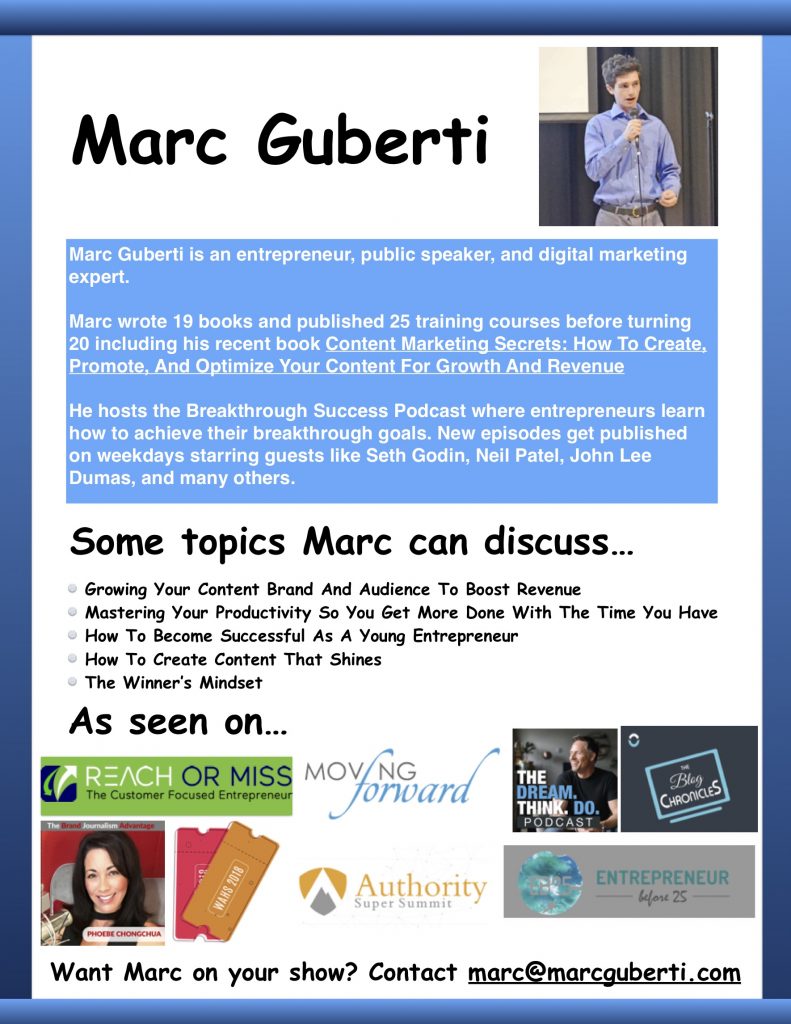
I opted against including a list of suggested questions on my 1-sheet because I rarely look at the suggested questions on other people’s 1-sheets. The problem with suggested questions is that some hosts may simply ask all of those suggested questions in the interview.
I prefer to create a different experience on my podcast by asking questions that few people would think of. Similarly, I don’t want everyone asking me the same questions when I appear on other podcasts (except the backstory question which is virtually impossible to avoid and a good ice breaker).
Including your 1-sheet will increase the amount of yeses you hear from the podcast hosts you reach out to. You can create your 1-sheet using KeyNote/PowerPoint or Canva. For my 1-sheet, I used KeyNote and exported the slide as an image. Regardless of how you create your 1-sheet, it will work wonders for getting interviewed on more podcasts.
In Conclusion
Your podcast can bring in all of the clients you’ll ever need for your business. Before you start using your podcast to attract clients, set a monthly income target.
Then determine how many clients you need to hit your monthly target. Get clear on the numbers before you take action.
Then it comes down to interviewing many guests and attracting even more listeners to your show. Combine that with promoting your free strategy session, and you’ll have a winning formula for your podcast.
You can then take that winning formula on the road by appearing on other podcasts in your niche.
What do you use your podcast for? Do you have a podcast or are eager to start one? How are you attracting clients for your business? Have a question for me? Sound off in the comments section below.
Want to see how I can help you grow your podcast? Schedule a free strategy session today!








